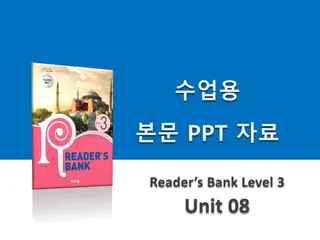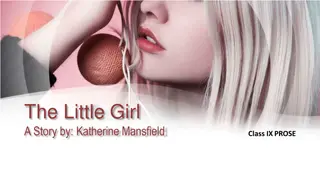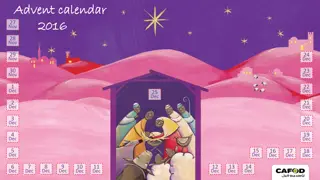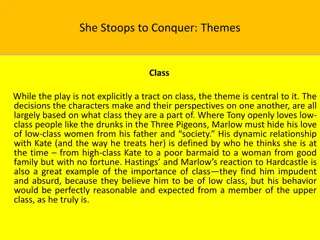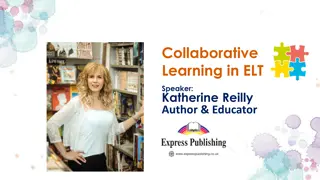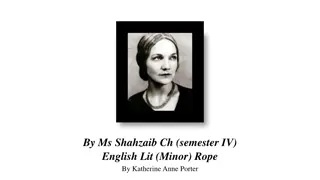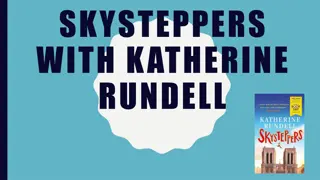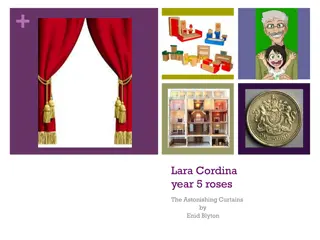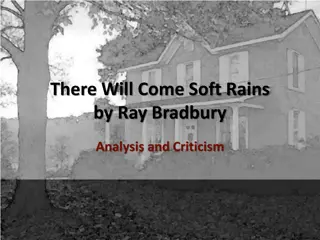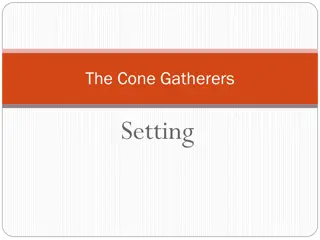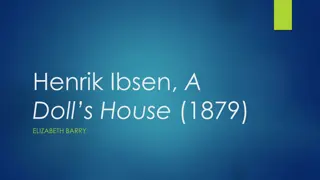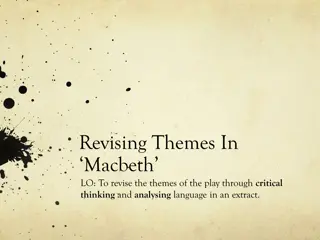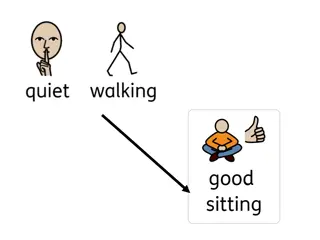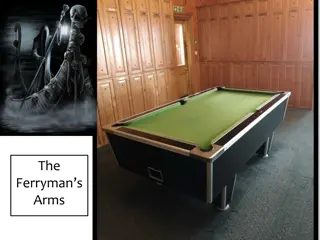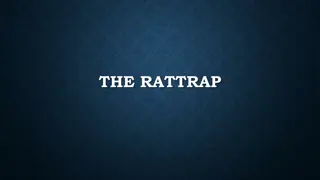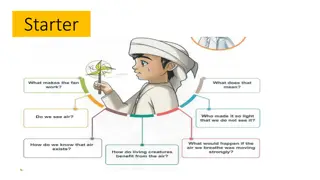Exploring Themes of Class Distinctions and Kindness in 'The Doll's House' by Katherine Mansfield
In "The Doll's House" by Katherine Mansfield, the story unfolds in a small New Zealand village in the early 20th century, portraying a community defined by class distinctions. The narrative centers around the burnell sisters; particularly Kezia, who defies societal norms by showing kindness to the Kelvey girls, faces prejudice and cruelty from classmates and adults alike. Through the symbol of a little lamp, the story highlights themes of social injustice, prejudice, hope, and the innocence of children. The plot development showcases the cruel consequences of class distinctions and the power of small acts of kindness in an oppressive society.
Download Presentation

Please find below an Image/Link to download the presentation.
The content on the website is provided AS IS for your information and personal use only. It may not be sold, licensed, or shared on other websites without obtaining consent from the author. Download presentation by click this link. If you encounter any issues during the download, it is possible that the publisher has removed the file from their server.
E N D
Presentation Transcript
Setting Symbol of snobbish community Setting: Small New Zealand village. Early 20thcentury. Community ruled by class distinction. Only 1 primary school all have to attend. Class distinctions.
Characters 1. Ms Hay giver of gift 2. Burnell sisters Isabel, Lottie, Kezia (cannot resist showing doll s house) 3. Isabel allowed to invite friends to see 4. Kelvey girls Liz and Else (only speak at end have no voice) 5. Mother 6. Aunt Beryl 7. Willie Brent
KEZIA Kezia is the youngest of the Burnell s children. ELSE Else is the youngest of the Kelvey s children. She is limited in what she can say because of her age. She is limited in what she can say because of her social circumstances. She is attracted to the little lamp which is a symbol of hope. She is attracted to the little lamp which is a symbol of hope.
Summary main points Ms Hay gives gift. Kezia impressed by lamp. Isabel allowed to bring friends to admire doll s house. Burnell parents do not allow the Kelveys. Horror of society accepted. One day Kezia invites the Kelvey girls. (Kezia attempts kindness) Aunt Beryl chases them away. Lil is embarrassed but Lise remembers the wonderful lamp. She is happy she and Kezia are innocent and have a sense of wonder. Lamp becomes a symbol of warmth/light/kindness.
Plot development 1. Opening given a doll s house. 2. Immediate complication has to remain outside (paint smell). 3. Next complication Kezia wants to show / Only Isabel allowed. 4. Further complication Kelveys not allowed. 5. Prejudice - Treat Kelveys like outsiders. 6. Climax Kezia invites Kelveys 7. Chased away cruel, snobbish attitude. 8. Resolution Lil is upset but Else is satisfied. Both little girls loved the lamp. 1. Twist of the threatening letter Aunt Beryl not so pure!
Themes Cruelty of class distinctions (even teacher uses special voice). Prejudice / social class (social and economic standing) Justice/ injustice Values Hope (opening of gate for Kelveys the selection of the lamp) Tone is satirical mocks the class-bound mentality and prejudices. Children are being brain-washed results in cruelty / bullying. Figuratively shoos them out like chickens / calls them little rats.
Themes Pride and prejudice; The cruelty of class distinctions; Social inequality; Injustice
Need to know Title: Symbolic of the class distinctions between the rich upper class and the poor. Setting: A New Zealand village in the 1920s. Climax: Aunt Beryl scolds Kezia and chases the Kelvey girls off the Burnell property.
Need to know Characterization: Kezia Burnell kind, innocent, sympathetic towards the Kelveys, the victims of the class system. She is independent disobeys her mother by inviting the Kelveys to see the Doll s House. Lil and Else Kelvey feel inferior represent the lower class Aunt Beryl unpleasant; unsympathetic; cold-hearted; cruel; snobbish forbids her children from having contact with the Kelveys. Willie Brent doesn t appear in the story probably Aunt Beryl s secret lover
The dolls house The doll s house Katherine Mansfield
The dolls house Where does the doll s house come from? Old Mrs Hay stayed with the family for some time; when she left, she sent the Burnell girls the doll s house What does the doll s house look like? It was painted a dark, spinach green. It had bright yellow lines to accentuate the green. It had a red and white roof. It had four real windows. It had a tiny porch, which was painted yellow. It had a drawing-room, a dining-room, kitchen and two bedrooms
Inside the dolls house It had red carpets, except for the It had red carpets, except for the kitchen. kitchen. A stove in the kitchen A stove in the kitchen The walls had wallpaper on it The walls had wallpaper on it The walls had pictures with gold The walls had pictures with gold frames on it. frames on it. Red chairs upholstered in luxurious Red chairs upholstered in luxurious material in the drawing material in the drawing- -room Green chairs in the dining Green chairs in the dining- -room Beds with real covers Beds with real covers A cradle in the room A cradle in the room In the middle of the dining room In the middle of the dining room table was an amber lamp. It looked table was an amber lamp. It looked as if there were oil inside it. as if there were oil inside it. room room
Two families in this short story Two families in this short story Burnell family Pat Burnell father Aunt Beryl very intent on not allowing the Kelvey girls into their yard. Isabel eldest sister Lotie middle sister Kezia the youngest; the only character who is not prejudiced The Burnells are rich Their daughters clothing set them aside from the others clothing. The Burnell girls shun the Kelveys. Isabel, the eldest, wants to tell their friends about the dolls house first.
The contrast between the Burnell sisters and the Kelvey sisters is because of their social status; the Kelveys are poor. The little sister, Else, clings to her sister, Lil.
Who invites them in to look at the dolls house? Who invites them in to look at the doll s house? Who chases them away? Who chases them away? Kezia She swings on the gate the gate is open She sees the two figures of the sisters approaching She opens the gate and invites them to see the doll s house Kezia is the only character that is not prejudiced Someone calls Kezia s name It was aunt Beryl She chases them away, in a way that reminds us of someone chasing chickens that is how little she thought of these children. Aunt Beryl reminds them that they should not even talk to these children.
Aunt Beryl Aunt Beryl She receives a threatening letter from Willie Brent to meet him He would come to her house if she did not comply. The reader is not informed about Willie Brent, but he must be outside Aunt Berryl s social circle because he threatens her, saying he would come to the house She feels satisfied that she chased the Kelveys away.
Imagery and symbolism Imagery and symbolism The doll s house represents upper class society expensive materialistic details, like the luxurious chairs, wall paper, carpets. The Kelveys are referred to in animal terms, showing they belong to a lower class. The lamp signifies truth, awakening it is important to Kezia and Else, because they share the same values. Kezia and Else are looking for friends, they are not interested in which social class they belong to.








